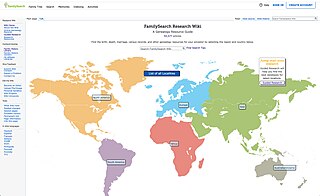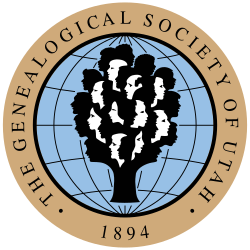
Genealogy is the study of families, family history, and the tracing of their lineages. Genealogists use oral interviews, historical records, genetic analysis, and other records to obtain information about a family and to demonstrate kinship and pedigrees of its members. The results are often displayed in charts or written as narratives. The field of family history is broader than genealogy, and covers not just lineage but also family and community history and biography.

The FamilySearch Library (FSL), formerly the Family History Library, is a genealogical research facility in downtown Salt Lake City. The library is open to the public free of charge and is operated by FamilySearch, the genealogical arm of the Church of Jesus Christ of Latter-day Saints.
The International Genealogical Index (IGI) is a database of genealogical records, compiled from several sources, and maintained by the Church of Jesus Christ of Latter-day Saints. Originally created in 1969, the index was intended to help track the performance of temple ordinances for the deceased.

Temple Square is a 10-acre (4.0 ha) complex, owned by the Church of Jesus Christ of Latter-day Saints, in the center of Salt Lake City, Utah. The usage of the name has gradually changed to include several other church facilities that are immediately adjacent to Temple Square. Contained within Temple Square are the Salt Lake Temple, Salt Lake Tabernacle, Salt Lake Assembly Hall, the Seagull Monument, and two visitors' centers. The square was designated a National Historic Landmark District in 1964, recognizing the Mormon achievement in the settlement of Utah.
Ancestry.com LLC is an American genealogy company based in Lehi, Utah. The largest for-profit genealogy company in the world, it operates a network of genealogical, historical records, and related genetic genealogy websites.
Granite Mountain is a mass of solid rock one mile up Little Cottonwood Canyon in the Wasatch Range of Utah, not too far from Salt Lake City, Utah. Despite its name, Granite Mountain is primarily composed of quartz monzonite, an igneous rock similar to granite in appearance, physical characteristics, and chemical composition. This is the same material used to construct the Salt Lake Temple and the facade of the LDS Conference Center.

FamilySearch Centers (FSC), formerly Family History Centers (FHC), are branches of the FamilySearch Library (FSL) in Salt Lake City, Utah, operated by the Church of Jesus Christ of Latter-day Saints. The centers supply resources for research and study of genealogy and family history. As of 2024, there are more than 6,316 FSC in 149 countries.

The BYU Family History Library (FHL) is located in the Harold B. Lee Library (HBLL) on the campus of Brigham Young University in Provo, Utah. It is one of the Family History Centers devoted to assisting library patrons in genealogical research. It began as a small section of the BYU library in 1962, and later expanded into a branch of the Family History Library, the genealogical library of the Church of Jesus Christ of Latter-day Saints, in 1964. It was formerly known as the Utah Valley Regional Family History Center. The BYU FHL houses a large collection of physical materials, such as microfilms, photographs, books, and other documents. It also offers access to digital materials, including genealogical databases and digitized newspapers. Scanners, computers, and printers are also available. The BYU FHL assists patrons online through its website, YouTube channel, and hosted webinars. It also offers classes in a variety of areas related to genealogy.
Archibald Fowler Bennett was a longtime employee of the Genealogical Society of Utah who was such a figure in the promotion of family history research in the Church of Jesus Christ of Latter-day Saints that he became known as "Mr. Genealogy".
MyHeritage is an online genealogy platform with web, mobile, and software products and services, introduced by the Israeli company MyHeritage in 2003. Users of the platform can obtain their family trees, upload and browse through photos, and search through over 19.9 billion historical records, among other features.
FamilySearch Indexing is a volunteer project established and run by FamilySearch, a genealogy organization of the Church of Jesus Christ of Latter-day Saints. The project aims to create searchable digital indexes of scanned images of historical documents that are relevant to genealogy. The documents include census records, birth and death certificates, marriage licenses, military and property records, and other vital records maintained by local, state, and national governments. However, to access the billions of names that appear on these images, indexes are needed to be able to search them efficiently.

The Church History Library (CHL) is a research center and archives building housing materials chronicling the history of the Church of Jesus Christ of Latter-day Saints. The library is owned by the Church and opened in 2009 in downtown Salt Lake City, Utah.
Richard Eyring "Rick" Turley Jr. is an American historian and genealogist. He previously served as both an Assistant Church Historian of the Church of Jesus Christ of Latter-day Saints and as managing director of the church's public affairs department.

WeRelate.org is an American wiki genealogy website that provides genealogy tools and data. WeRelate is a non-profit and is funded by tax-deductible donations and is managed by unpaid volunteers. WeRelate had over 2 million person pages by March 2011 and claimed to be the "world's largest genealogy wiki".
GenealogyBank.com is an online subscription genealogical service that provides access to records useful in family history research. GenealogyBank is one of the largest collections of digitized U.S. newspapers, dating back to 1690. In addition to digital newspaper archives, GenealogyBank also offers other online genealogy resources including the Social Security Death Index, obituaries, government publications, and historical books.

The Family History Research Wiki provides reference information and educational articles to help genealogists find and interpret records of their ancestors. It is a free-access, free-content, online encyclopedia on a wiki, hosted as part of the FamilySearch site. It is sponsored by FamilySearch, a non-profit organization and genealogical branch of The Church of Jesus Christ of Latter-day Saints. Anyone may read any of the articles, and almost all articles can be edited by registered users (contributors); registration is free.
James William Grant FRSE FRAS, 3rd Laird of Wester Elchies (1788–1865) was a Scottish astronomer and landowner. On 23 July 1844 he was the first person to observe and record the existence of the star Antares B.
Philanthropies, formerly LDS Philanthropies, is a department of the Church of Jesus Christ of Latter-day Saints and is responsible for facilitating donations to humanitarian and educational initiatives. The department works under the direction of the church's Presiding Bishop. The most widely known educational projects are the operation of church-owned schools, such as Brigham Young University (BYU). Humanitarian funds are given to Latter-day Saint Charities which sponsors and organizes relief efforts. In 2019, the church reported over 3,000 community-based projects with an excess of 2,000 partners, in locations around the world. A 2020 statistic reported a total of $2.3 billion that had been donated over Philanthropies' existence.
Geneanet is a genealogy website with 4 million members. The database consists of data added by participants and is intended for all genealogists. The website is collaborative and the data added by the members are available for free to any interested people. An optional annual subscription provides additional search options and additional records.










